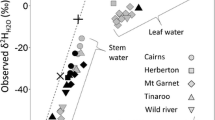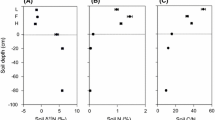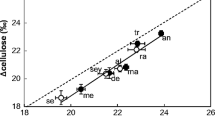Abstract
Key message
Eucalyptus and Acacia species were surprisingly similar with respect to variations in δ 13 C, δ 15 N. Both genera respond with speciation and associated changes in leaf structure to drought.
Abstract
Stable carbon and nitrogen isotope ratios (δ13C and δ15N) in leaves of eucalypts (Corymbia and Eucalyptus) and Acacia (and some additional Fabaceae) species were investigated together with specific leaf area (SLA), leaf nitrogen (N) and leaf phosphorous (P) concentration along a north–south transect through Western Australia covering winter- and summer-dominated rainfall between 100 and 1,200 mm annually. We investigated 62 eucalypts and 78 woody Fabaceae species, mainly of the genus Acacia. Leaf δ13C values of Eucalyptus and Acacia species generally increased linearly with latitude from −29.5 ± 1.3 ‰ in the summer-dominated rainfall zone (15°S–18°S) to about −25.7 ± 1.1 ‰ in the winter-dominated rainfall zone (29°S–31°S). δ15N increased initially with southern latitudes (0.5 ± 1.6 ‰ at 15°S; 5.8 ± 3.3 ‰ at 24–29°S) but decreased again further South (4.6 ± 3.5 ‰ at 31°S). The variation in δ13C and δ15N was probably due to speciation of Eucalyptus and Acacia into very local populations. There were no species that were distributed over the whole sampling area. The variation in leaf traits was larger between species than within species. Average nitrogen concentrations were 11.9 ± 1.05 mg g−1 in Eucalyptus, and were 18.7 ± 4.1 mg g−1 in Acacia. Even though the average nitrogen concentration was higher in Acacia than Eucalyptus, δ15N gave no clear indication for N2 fixation in Acacia. In a multiple regression, latitude (as a surrogate for rainfall seasonality), mean rainfall, leaf nitrogen concentration, specific leaf area and nitrogen fixation were significant and explained 69 % of the variation of δ13C, but only 36 % of the variation of δ15N. Higher nitrogen and phosphorus concentration could give Acacia an advantage over Eucalyptus in arid regions of undefined rainfall seasonality.







Similar content being viewed by others
References
Austin AT, Sala OE (1999) Foliar δ15N is negatively correlated with rainfall along with the IGBP transect in Australia. Aust J Plant Physiol 26:293–295
Brockwell J, Searle SD, Jeavons AC, Waayers M (2005) Nitrogen fixation in Acacias: an untapped resource for sustainable plantations, farm forestry and land reclamation. Australian Centre for International Agricultural Research. CSIRO ACIAR Monogr 115:1–132
Cook GD (2001) Effects of frequent fires and grazing on stable nitrogen isotope ratios of vegetation in northern Australia. Aust Ecol 26:630–636
Farquhar GD, O’Leary MH, Berry JA (1982) On the relationship between carbon isotope discrimination and the intercellular carbon dioxide concentration in leaves. Aust J Plant Physiol 9:121–137
Farquhar GD, Hubick KT, Condon AG, Richards RA (1989) Carbon isotope fractionation and plant water-use efficiency. Ecol Studies 68:21–40
Groves HR (1981) Australian vegetation. Cambridge University Press, Cambridge, p 449
Huber E, Bell TL, Adams MA (2013) Combustion influences on natural abundance nitrogen isotope ratio in soil and plants following a wildfire in a sub-alpine ecosystem. Oecologia 173:1063–1074
Johnson RW, Burrows WH (1981) Acacia open-forest, woodlands and shrublands. In: HR Groves (ed) Australian vegetation. Cambridge University Press, Cambridge, pp 177–197
Maier SW, Russell-Smith J (2012) Measuring and monitoring the contemporary fire regimes in Australia using satellite remote sensing. In: RA Bradstock, AM Gill, RJ Williams (eds) Flammable Australia: fire regimes, biodiversity and ecosystems in a changing world. pp 79–95
Miller JM, Williams RJ, Farquhar GD (2001) Carbon isotope discrimination by a sequence of Eucalyptus species along a subcontinental gradient in Australia. Funct Ecol 15:222–232
Nicolle D (2003) Currency Creek Arboretum (CCA) Eucalyptus research. http://www.dn.com.au/Currency_Creek_Arboretum.html
Schulze ED, Williams RJ, Farquhar GD, Schulze W, Langridge J, Miller JM, Walker BH (1998) Carbon and nitrogen isotope discrimination and nitrogen nutrition of trees along a rainfall gradient in northern Australia. Aust J Plant Physiol 25:413–425
Schulze ED, Farquhar GD, Miller JM, Schulze W, Walker BH, Williams RJ (1999) Response: interpretation of increasing foliar δ15N in woody species along a rainfall gradient in northern Australia. Aust J Plant Physiology 26:296–298
Schulze ED, Beck E, Müller-Hohenstein K (2002) Plant ecology. Springer, Heidelberg, p 702
Schulze ED, Turner NC, Nicolle D, Schumacher J (2006a) Leaf and wood carbon isotope ratios, specific leaf areas and wood growth of Eucalyptus species across a rainfall gradient in Australia. Tree Physiol 26:479–492
Schulze ED, Turner NC, Nicolle D, Schumacher J (2006b) Species differences in carbon isotope ratios, specific leaf area and nitrogen concentrations in leaves of Eucalyptus growing in a common garden compared with along an aridity gradient. Physiol Plant 127:434–444. doi:10.1111/j.1399-3054.2006.00682.x
Shearer G, Kohl DH (1989) Estimates of N2 fixation in ecosystems: the need for and the basis of the δ15N natural abundance method. Ecol Studies 68:342–374
Smith SE, Read DJ (1997) Mycorrhizal symbiosis, 2nd edn. Academic, San Diego, p 605
Steward GR, Turnbull MA, Schmid S, Erskinn PD (1995) δ13C natural abundance in plant communities along a rainfall gradient: a biological integrator of water availability. Aust J Plant Physiol 22:51–55
Turner NC, Schulze ED, Nicolle D, Schumacher J, Kuhlmann I (2007) Annual rainfall does not directly determine the carbon isotope ratio of leaves of Eucalyptus species. Physiol Plant 132:440–445. doi:10.1111/j.1399-3054.2007.01027.x
Turner N, Schulze ED, Nicolle D, Kuhlmann I (2010) Growth in two common gardens reveals species by environment interactions in carbon isotope discrimination of Eucalyptus. Tree Physiol 30:741–747. doi:10.1093/treephys/tpq029
Virginia RA, Jarrell WM, Rundel PW, Shearer G, Kohl SC (1989) The use of variation in the natural abundance of 15N to assess symbiotic nitrogen fixation by woody plants. Ecol Studies 68:375–394
Acknowledgments
We acknowledge the help of Ludwig Leidinger and Jens Schumacher with R-statistical package and the multivariate analysis of isotope data. We also acknowledge the support of Malcolm French in identifying some of the problematic Eucalyptus species in the field, and of Bob Nicolle during the fieldwork, and of Iris Kuhlmann, Ines Hilke and Heike Geilmann for processing the samples and maintaining the database. We thank an unknown referee for very valuable comments.
Conflict of interest
The authors declare that they have no conflict of interest.
Author information
Authors and Affiliations
Corresponding author
Additional information
Communicated by A. Gessler.
Rights and permissions
About this article
Cite this article
Schulze, E.D., Nicolle, D., Boerner, A. et al. Stable carbon and nitrogen isotope ratios of Eucalyptus and Acacia species along a seasonal rainfall gradient in Western Australia. Trees 28, 1125–1135 (2014). https://doi.org/10.1007/s00468-014-1023-0
Received:
Revised:
Accepted:
Published:
Issue Date:
DOI: https://doi.org/10.1007/s00468-014-1023-0




